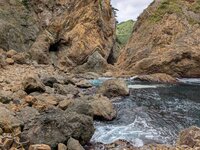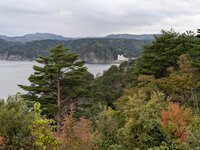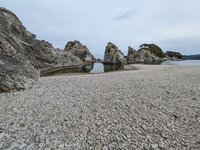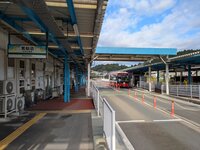
After Hachinohe, we continued our trundle down the eastern seaboard accompanied by one man and his train. Part of the way was aboard the "LaLa Train", which appeared to be the locals' attempt to decorate their train in the expected Hello Kitty style. Since this is the coast that was battered by the 2011 tsunami, perhaps such frivolities can be forgiven.
All along this route, we saw evidence of the tsunami. Principally in the form of reconstruction and newly built and massive sea defences. Everyone knows this was an horrific event, but the scale is hard to grasp. The incoming wall of water was up to 40m high was moving at over 400mph and travelled inland for six miles. It was the fourth most powerful earthquake ever recorded. 20,000 people died pretty much straight away with another 8,000 injured or missing. A quarter of a million people were displaced. Oh, and of course three reactors melted down at Fukushima!
Often our train trundled along behind recently built and massive concrete sea defences. Occasionally we were on the outside - which was a little disconcerting. There is something weird about looking at the sea and no longer being quite so confident that it is going to stay where it belongs.
Tanohata
Our hotel in Tanohata is right on the sea shore....
The Hotel Ragaso was badly damaged in the tsunami (particularly up to the third floor) and afterwards became a base for recovery workers. Our room has a sea view and is on the ninth floor. The rooms are all decorated in typical Japanese style with tatami mats and hopelessly impractical paper walls and doors. For all it is a relatively luxurious hotel (for us), we still have to sleep on the floor.

We came here to walk some more of the Michinoku Coastal Trail. In particular the section from Kitayamazaki back to our hotel. This 9 mile stretch consists of very steep downhill stages alternating with brutal climbs. The cliffs are about 200m high, so we climbed up and down this height a fair few times. Occasionally, some helpful souls had hand-cut tunnels between the beaches which meant we didn't have to make the climb. At one point, a ladder was used to get up an awkward bit. Much of the walk was in woodland and we were frequently reminded to be on the lookout for bears. The views on this walk were spectacular. Pristine beaches and dramatic cliffs - and plenty of blue water.
Towards the end of this walk, we passed by a memorial constructed to remind people of what happened during the tsunami. Actually, it is mainly just part of the old sea defences that were completely overwhelmed and destroyed by the waves. It turns out that the initial wave was so large, it passed completely over the sea wall and it was the subsequent outflow of that same water that destroyed the defences from the back. A completely unexpected attack vector. We have seen many examples of the way Japan has adapted after the 2011 quake. It is encouraging and inspiring to see how proactive they have been in ensuring the same damage and loss of life does not happen again. Of course, only time will tell if this has been successful, byut we are left wondering if our own country would be so keen to protect its citizens.
Hotel Ragaso has done us proud on the food front. It seems as though for each consecutive night you stay here, there is a different banquet served. As we have been here afew days, we can observe the other guests and know how long they have been here by which if the meals they are served. Most dinners include some variety of excellent sashimi, generally a seafood hotpot and something to grill - beef, tuna, prawn, etc. There are also numerous small dishes containing unidentifiable bits of... stuff. It all seems to be very good quality if a little daunting. The hotel also has an onsen which we have rather taken to. Who doesn't like a long hot soak after a long hot walk? Even if it involves being naked with a load of old Japanese people (no pictures of this bit).
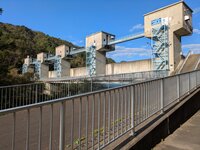
We have jumped on a few trains to explore the local area (yes, including LaLa again). We made a quick trip down to Miyako to visit Jodogahama Beach which is apparently one of the top 100 best beaches in Japan. It was a pretty enough little place, but we concluded that Japan probably doesn't have many more than 100 beaches. On our final day here, we did another section of the Michinoku Coastal Trail. This time from Kitayamazaki again, but heading north to Fudai. The walk comprised far fewer steps than the last section we did and was really rather pleasant, winding along the clifftops. This path tended to contour around valleys rather than attempt to go down and up again all the time, which made it a lot less arduous. This was a good thing as after about 8 miles we realised that we could just make the 3pm train rather than having to wait until 5pm. This made for a rather grueling slog along a road, but we did make it with a few minutes to spare. Amusingly, we lowered the pace as we approached Fudai station only to discover that we couldn't find the entrance! We did make it in the end including having to ask for the ticket office to be opened for us.
Generally speaking, the cliffs around here, being 200m high, protected the inland areas from the tsunami. However, all the low-lying areas around river mouths, etc were inundated. Unsurprisingly, there are the most densely populated areas. The tsunami raced far inland up these river valleys. Nowadays, there is lots of evidence of flood defences. The town of Fudai itself was pretty well protected from the worst of the flooding since the town mayor famously fought tooth and nail to have flood defences built prior to the event. He had read his history books and learned. Over the last 100 years, the town had been flooded twice due to quake related events and he was adamant that it would not happen again. The council and even the local populous objected to spending so much money on a concrete wall, but the mayor prevailed. Fudai is right on the coast and one person died during the 2011 tsunami - and he went outside the wall to check on his boat. Well done, Mayor Yukito Wamura!
Kesennuma
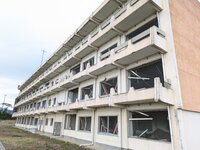
The trip down the coast to the port of Kesennuma involved two trains and a bus. The first section from Tanohata was on everyone's favourite LaLa train. We had a 10 min connection at Miyako during which time we had to lug our bags off the train, go off in search of tickets for the onward journey and then find the train. The thing with train travel in Japan is that, if the published schedules says you have 10 mins, then you have 10 mins. No more, no less. Needless to say, we made it with minutes to spare. We had learned that, upon arrival at Sakari, we had to switch to what used to be a JR train to Kesennuma. However, the line was destroyed in the tsunami and has not been rebuilt. What has happened is that the rail line has been covered in tarmac and JR run a BRT (Bus Rapid Transit) along the route, complete with the usual barrier crossings and all the features of a railway line. What a great idea. Sadly for us, the route was under maintenance of some kind and we ended up going round the houses on normal roads like poor people. Being Japan, we only deviated by 10 mins from the published timetable. Had we been able to read Japanese, we probably would have been aware of all this.
All down this coastal route, we saw evidence of the tsunami and the incredible amount of work going on to prevent a recurrence of the disaster. Pretty much every coastal town and village has a large sea wall. It's as though this entire north eastern coast is either tall cliffs or concrete wall. It's a massive feat of engineering. It is to be hoped that it is enough.
Kesennuma took a particular beating and, in addition to the rather obvious sea-wall, they have a memorial museum set up in a school that was a mere 500 yards from the sea - until it wasn't. Happily, the students all survived due to the quick actions of the teachers, but the building was heavily damaged. It now stands, undistrubed in memory of the event. The is a small display of photographs showing before and after and a rather harrowing video showing footage taken at the time. Afterwards, it is possible to visit the school and tour around some of the classrooms to see the state they have been left in. There is debris everywhere including a car that was deposited in a third floor classroom. A very moving display.
This town has had more than its fair share of disasters. There was a large fire in 1915 and then, in 1929 the entire city was destroyed by yet another fire. Each time the place has been rebuilt and to say it has an indomitable spirit would be an understatement. Today it is a nice welcoming place and, on the surface, people seem happy and relaxed. What is going on beneath the surface is beyond our ken. We only spent a couple of days here, but we liked the place and came away both humbled and impressed.
Some Pictures
